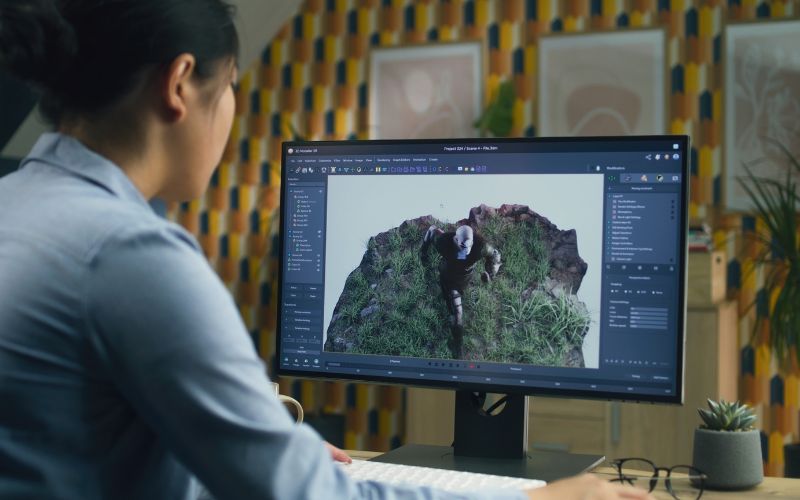How Do Animators Build a Strong Portfolio?
Do you want to be an animator? Then, you must work on your portfolio. For an animator, the portfolio is more essential than their resume. No matter if you’re doing a BSc in animation or you have a client who wants to see your work, you need your portfolio handy. The client will not take your word for consideration when it comes to animation. Rather, after reviewing your portfolio, a company or a client can consider hiring you. If you’re applying to work in a studio or as a freelancer, by taking a glance at your portfolio, the recruiters will understand what you can offer the respective place.
Your portfolio is not just a collection of work, but also a collection of experiences. It is a way you market yourself as an animator. A strong portfolio should consist of not only the final work but also the steps and methods that you followed to achieve the final product.
If you also want to build a strong portfolio for your animation career, here are the tips you can follow.
Tips to Build a Strong Portfolio for Your Animation Career
To have a seamless career in the animation industry, you need to create a portfolio that stands out from the rest. Here are the tips you can use to achieve it.
1. Give an Introduction
While creating a portfolio, ensure to name the work. If you’re applying for a job at the studio or an individual client, they might receive hundreds of portfolios every day. They can’t remember everyone simply by the work. It is thus important that you put your name on the animation portfolio. Furthermore, you should include your contact details so that the studio or client can connect with you if they’re impressed with your work.
2. Bring Life to the Characters or the Object
Animation is about bringing life to the characters or objects. Hence, when you apply for an animation job, the recruiters would want to see if you can excel in this skill. To ensure you can put life in a character, you need to work on your portfolio. The characters that you add to the portfolio should reflect nuance, movement and mechanics: things that are required in the animation business. All characters don’t necessarily have to be super expressive, some of them can be subtle. As an animator, you should include even those characters which emote subtle movement.
3. Make Your Portfolio Unique
The animation industry is very competitive. To get a job in that sector, you need to present your portfolio to the recruiters or clients in a unique way. You can pick a trending idea. For instance, aspiring animators can use cookie-cutter models and present their animation portfolio like a reel. However, many animators may use the same technique to create their portfolios. Then how can you make your portfolio different? You analyse different styles and use your knowledge and skills to create a portfolio that resonates with your uniqueness.
4. Add The Best Work
While creating your animation portfolio, don’t just consider showcasing the entire work that you have done so far. Rather, add your best animation work that you have made independently or in teams. As a fresher, you can add the work for which you have received recognition. This could be school projects and even personal work. If you’ve had a BSc in animation, you must have worked on an array of animation projects. Include the ones which you and your mentors have considered the best. If you’re including a collaborative project, ensure to add a note on the part of the project you were responsible for.
5. Your Portfolio Should Match Your Role
To work in the animation industry, it is essential to have an animation portfolio in different versions. Create a generalised one that can be used everywhere and one that is personalised to your specific interests and roles. If you want to apply for an animation job in a particular industry or niche, you can add your previous work that is relevant to that niche. For instance, if you’re applying for the role of a 3D animator in the video game industry, then you can add some video clips that you’ve worked on instead of including 2D anime drawings.
6. Prioritise Quality Before Quantity
When you make your animation portfolio, instead of putting everything, choose the ones that reflect your advanced skills. If you want to work at a reputed animation studio, tailor your work to the specific job roles. You can also do the same if you’re applying for an animation job in a particular niche. Ensure that your animation styles and skills match the job description. As a beginner, you may get confused when it comes to choosing the best clip for your portfolio. In such cases, you can seek help from your mentor or friends. Shortlist the work that you consider the best and show them to your guidance expert.
7. Don’t Make the Portfolio Too Long
As a future animator, focus on creating a portfolio that holds all your important and most recognised work. However, don’t make it too long. Understand that recruiters review at least a hundred applications every day. Their attention span is too short. Hence, ensure to make your animation portfolio concise and well-organised. They may have 30 seconds to 1 minute to spare on your portfolio, so when you build your animation portfolio, include the important and relevant work first. Also, mention the processes and styles for all your work in brief, so that recruiters can take a swift glance and evaluate your profile.
8. Promote Your Portfolio
After you’ve created a well-organised and concise animation portfolio, it’s time to reach out to a large number of audiences. Attach your portfolio on social media sites, like Instagram and Facebook. You can also attach the link to your portfolio on LinkedIn to grab the attention of different recruiters, animation studios and independent clients. You can promote your portfolio on other sites as well and let your followers know where they can find your work.
Conclusion
Making a strong portfolio is essential when you start your career as an animator. For other professions, the interviews and aptitude tests may determine the hiring. But in this creative pursuit, clients and animation studios would want to see your work, analyse it and give you a job offer if they find it suitable. Include your best work that reflects your most advanced skills.
Looking for animation courses near you? Your search ends with Moople Academy. Offering various professional courses, Moople is the best destination to learn animation and graphics. By incorporating AI capabilities, Moople Academy has taken BSc in Animation Film Making, BSc in VFX Film Making and 3D Gaming to a whole new level. To learn more about animation courses, you can reach out to Moople’s team.










